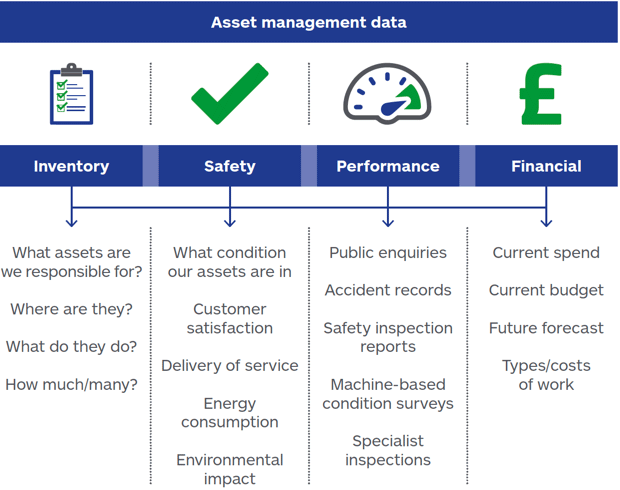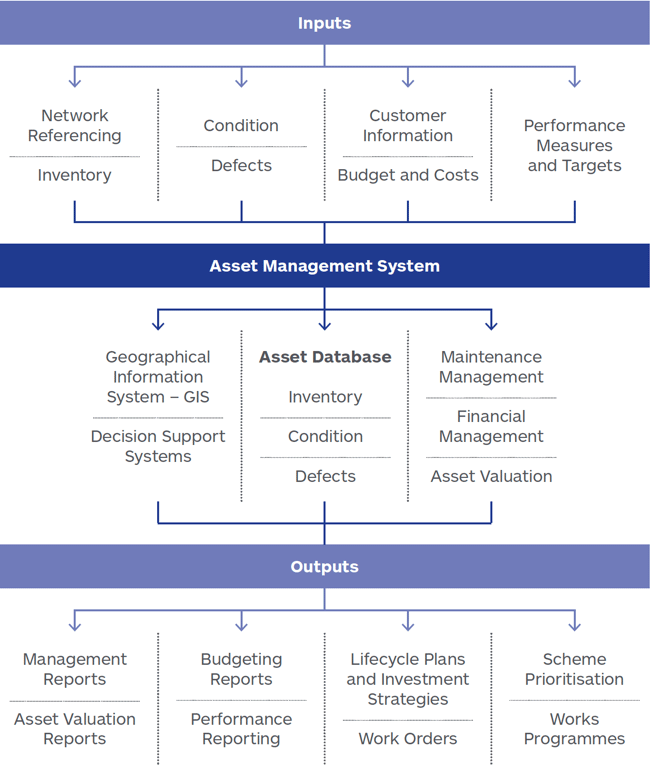6. Our Approach
Scottish Trunk Road Network Asset Management Strategy: November 2018
6. Our Approach
Data
Data is essential for us to deliver effective asset management using an evidence-based approach to enable informed decision making, visualise performance and manage risks.
We are looking to enhance our capability in capturing and managing data, in order to improve its quality and efficiency.
Why is data important to us?
Data is critical for us to understand our asset and how we can best manage it for the benefit of Scotland. We can transform data into valuable information and ultimately knowledge about the assets we are managing, which can be used to:
- Describe the asset and how it is performing;
- Support effective asset planning and decision making;
- Inform decision making related to asset maintenance or replacement;
- Communicate with suppliers, customers, communities and other stakeholders;
- Identify and manage risks, turning them into opportunities where possible;
- Determine long-term investment requirements; and
- Support us in our continuous improvement plans.
What types of data do we have?

How do we manage data?
Data is an asset, just like our roads and bridges, so it must be managed carefully. To support this, our Information Strategy:
- Defines how Transport Scotland collates, maintains and utilises asset information;
- Records the approach to defining information requirements, accounting for the benefits and costs of collecting and maintaining information;
- Documents committed and proposed improvements to asset information;
- Demonstrates how information supports our asset management objectives;
- Assesses the risks of not having, or not maintaining, asset information; and
- Demonstrates suitable arrangements are in place for data security and protection.
Data quality is also important, so our supply chain is required to have certified quality management systems in place. We regularly audit the quality of data we receive from suppliers and encourage continuous improvement through training and support. Our future plans are based on opportunities identified and lessons learnt from our current processes.
The security of our data is paramount. To ensure this, we have robust security and information assurance practices, which support the confidentiality, integrity and availability of data and systems. This includes our responsibilities under the General Data Protection Regulations (GDPR).
What plans do we have for the future?
In an increasingly digital world, there are opportunities and challenges for Transport Scotland to improve the availability, quality and confidence in our data, whilst reducing the associated costs. We are already working on several improvements, such as:
- enhancing our requirements for data management within our supply chain to enhance accountability for the provision of accurate and meaningful data;
- developing our capabilities in data analytics to add value to the existing data held within our systems and use this to support decision making; and
- trialling innovative technology to improve the safety, quality and efficiency of data collection, leading to a better understanding of our assets.
Our Information Strategy is updated regularly to ensure that it continues to direct Transport Scotland towards better use and understanding of our data and incorporates technology improvements we make.
Tools
We have tools in place to manage our extensive asset databases, and support our decision making.
We will continue to integrate and enhance our digital tools.
Managing data, making sense
Our asset management systems allow data to be processed and analysed using integrated software, decision support tools and engineering knowledge, to provide information on location and performance of trunk road assets. This enables us to make informed decisions on asset investment and report performance in a meaningful way.
What systems do we have?

Managing a complex set of assets and functions requires a broad range of specialised systems. The diagram below provides an overview, along with examples of the outputs that inform our processes and wider decision making.
A key component of this is our Integrated Road Information System (IRIS), a Geographical Information System (GIS) map-based asset management system linking condition data with inventory, accidents, structures, drainage, construction, customer services, routine maintenance, works ordering/payment and street lighting. By managing our data more efficiently in this holistic way it enables improved investment decisions.
How do we use our tools effectively?
We recognise the importance of competent staff to ensure that our asset management systems are accessible to those involved in managing the trunk road assets, and to ensure they have the information and data required to undertake their role effectively.
What plans do we have for the future?
We are creating a new platform for our asset management system, which is being developed through understanding our user's requirements. This will incorporate best in class solutions to enable greater access to information including interfacing with supply chain systems and sharing of data to support informed decision making.
We have a roadmap for improving and developing our tools, to take advantage of technology changes without disrupting day-to-day operations.
Processes
We have developed a series of end-to-end processes that are embedded throughout our staff and supply chain.
We are enhancing our processes through a combination of integration across the Asset Management framework, aligning our digital approaches and learning from experience of ourselves and industry best practice.
Consistent and effective processes for asset management
We recognise that our asset management processes set out in the RAMP have to be effective to maximise the value from investment in trunk road maintenance. As part of the specification of our new Network Maintenance Contracts (NMC), which will commence from 2020 onwards, we have reviewed the processes upon which the successful delivery of the contract relies. This ensures that the processes are designed to deliver the objectives of the contract and, ultimately, our asset management objectives.
A consistent approach is vital for effective contract management – to enable our staff to understand their responsibilities we have developed a Road Asset Management Manual (RAMM) which defines how the RAMP is delivered.
The RAMM documents:
- The information, processes and technology required to support road asset management;
- The approach for the implementation and continual improvement of asset management processes and practices; and
- How ISO 55000 is embedded in the processes and practices of the Roads Directorate.
How we categorise our network
We have a defined hierarchy for our trunk road network, which considers current and expected use, resilience, and local economic and social factors such as industry, schools and hospitals. Having a well-defined and developed hierarchy enables us to prioritise our investments across the trunk road network.
What plans do we have for the future?
As part of the commitment to continual improvement, the RAMM and the procedures it contains will be reviewed and updated to take account of emerging Scottish Government and Transport Scotland corporate policies, best practice from elsewhere, changes in priorities and any technology impacts in how journeys are undertaken on the trunk road network.
In particular, we will align the specification for our Network Maintenance Contracts to align with the RAMM. We will share the RAMM with our supply chain to ensure that there is consistency across the asset management regime. We will use technology to make the RAMM more interactive and user-friendly and promote its use.
We are currently reviewing the trunk road network hierarchy to ensure that it continues to reflect the function of the network. In line with best practice, we will continue to regularly review the hierarchy so that investments are consistently correctly prioritised.